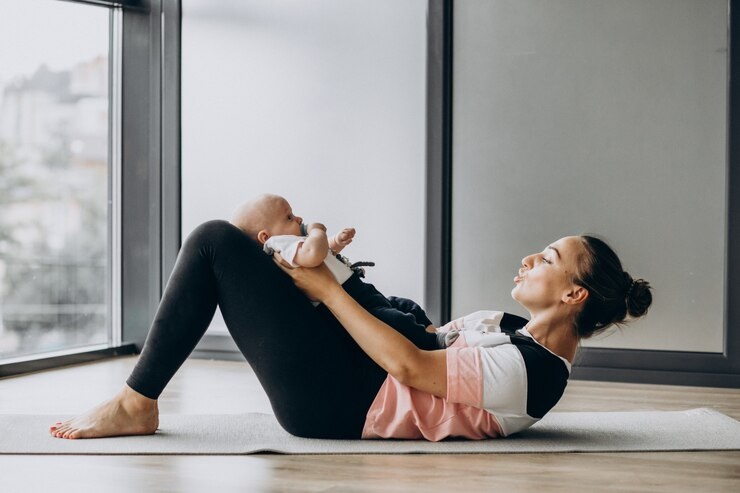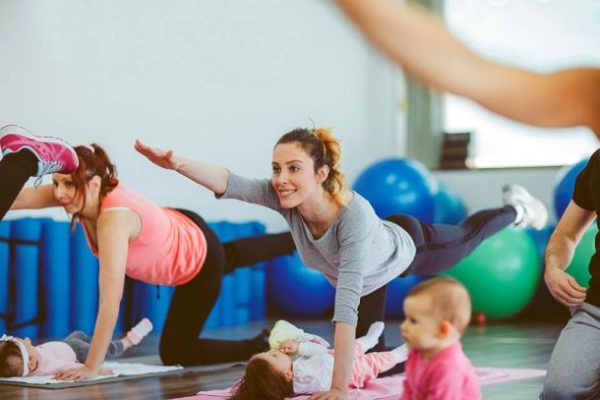The journey through pregnancy and childbirth is an awe-inspiring and transformative experience. However, after the baby is born, many women face a new challenge: regaining their pre-pregnancy fitness and strength. Postpartum fitness is not just about aesthetics or quickly shedding weight; it’s about reclaiming physical and emotional strength, improving overall health, and reconnecting with one’s body after the immense changes it has undergone. In this article, we’ll explore the key aspects of postpartum fitness, the importance of a gradual approach, and the real results that can be achieved through dedication and patience.
The Postpartum Period: A Time of Transition
Postpartum recovery refers to the period following childbirth during which a woman’s body heals and returns to a state of equilibrium. While some of the physical changes—like weight gain, stretch marks, or the loss of muscle tone—are visible, many of the most profound transformations occur internally. The pelvic floor, abdominal muscles, and cardiovascular system undergo significant changes during pregnancy and childbirth, and it takes time for these areas to regain strength and function.
In addition to these physical changes, the emotional and mental aspects of postpartum recovery are crucial. Many women experience mood swings, anxiety, or even postpartum depression, which can hinder the motivation to engage in physical activity. A balanced approach to postpartum fitness acknowledges the need for both physical and emotional healing, setting realistic goals that prioritize long-term health over quick fixes.
The Benefits of Postpartum Fitness
Engaging in postpartum fitness offers a myriad of benefits, both physical and emotional. Regular exercise after childbirth not only helps with weight management but also improves energy levels, supports mental health, and accelerates the body’s recovery process. Below are some of the key benefits:
-
Physical Recovery and Rehabilitation: Postpartum fitness is vital for strengthening muscles that were stretched or weakened during pregnancy. The core, particularly the abdominal muscles, often requires targeted exercises to repair the diastasis recti (separation of the abdominal muscles). Pelvic floor exercises are essential as well, as pregnancy and childbirth can weaken the pelvic floor muscles, leading to incontinence or other complications.
-
Mental Health Benefits: Physical activity has been shown to release endorphins, which promote feelings of happiness and well-being. For many new mothers, exercise can serve as a stress-reliever, offering a sense of control and accomplishment amidst the challenges of motherhood. It can also improve sleep quality, which is often disrupted in the early months of parenting.
-
Increased Energy Levels: Many new mothers report feeling drained or fatigued in the postpartum period due to sleepless nights and the demands of caring for a newborn. Regular exercise helps to increase stamina and energy levels, making it easier to cope with the physical demands of daily life.
-
Weight Loss and Body Composition: Although losing weight is not the sole focus of postpartum fitness, physical activity helps to burn calories, regulate metabolism, and maintain a healthy body composition. Gradually returning to pre-pregnancy weight is often a natural byproduct of a consistent exercise routine that includes both cardio and strength training.
Realistic Expectations: The Importance of Patience
One of the most important things to understand about postpartum fitness is that it is a gradual process. Women should set realistic expectations for themselves and their bodies during this time. It’s essential to avoid the pressure to “bounce back” to a pre-pregnancy body within weeks. This societal expectation is not only unrealistic but also unhealthy. The body has undergone significant changes, and healing takes time.
Most experts recommend waiting until the six-week postpartum check-up before beginning any intense physical activity, although some women may be ready to engage in light exercises earlier, depending on their recovery. This is particularly important for women who have had a C-section or experienced complications during childbirth, as their bodies may need more time to heal.
A Gradual Approach to Postpartum Fitness
The foundation of postpartum fitness should be built upon a steady, sustainable approach. Quick fixes and extreme workout regimens can be counterproductive, leading to injury or burnout. Below are some key elements of a successful postpartum fitness journey:
-
Start with Pelvic Floor Exercises: The pelvic floor muscles, which support the bladder, uterus, and bowel, are often weakened during pregnancy and childbirth. Strengthening these muscles is crucial to preventing incontinence and supporting overall core strength. Pelvic floor exercises, such as Kegels, can be done early on in the postpartum period and should be incorporated into any fitness plan.
-
Core Strengthening: One of the most common concerns for postpartum women is the restoration of core strength, particularly addressing diastasis recti. Gentle core exercises, such as pelvic tilts, bridges, and modified planks, can help heal the abdominal muscles. It’s important to avoid traditional crunches or sit-ups, which may exacerbate diastasis recti.
-
Gradual Cardiovascular Exercise: Light cardiovascular exercises such as walking, swimming, or cycling are excellent ways to ease back into fitness. These activities help improve cardiovascular health, burn calories, and increase energy levels without putting undue stress on the body. Gradually increasing the intensity and duration of these exercises will help avoid injury and promote long-term progress.
-
Strength Training: Once the body is ready, incorporating strength training exercises is crucial for rebuilding muscle mass and improving bone density. Resistance training can help tone the muscles, improve posture, and increase metabolism. Simple exercises using body weight, resistance bands, or light weights are ideal for new mothers.
-
Rest and Recovery: Perhaps one of the most overlooked aspects of postpartum fitness is the importance of rest. Sleep deprivation and physical exhaustion can impair the body’s ability to recover from exercise, so it is essential to listen to your body and rest when needed. Balance your workouts with adequate recovery time to avoid overtraining.
Real Results: Women’s Success Stories
While every postpartum journey is unique, many women have experienced real, transformative results from engaging in regular fitness routines. These results are often seen not only in physical improvements but also in mental and emotional well-being.
For instance, a study published in the Journal of Physical Activity and Health found that women who engaged in regular postpartum exercise had a greater sense of well-being, lower levels of depression, and higher self-esteem. Similarly, many women report regaining their pre-pregnancy strength and fitness levels after several months of consistent exercise, even if they don’t necessarily return to their exact pre-pregnancy body shape.
Take the example of Sarah, a new mother who felt overwhelmed by her physical changes after childbirth. Initially, she struggled with diastasis recti and pelvic floor weakness, but after working with a physical therapist and focusing on core strengthening and pelvic floor exercises, Sarah was able to regain function and strength. Within six months, she had incorporated strength training and cardiovascular exercises into her routine, helping her feel stronger, more energetic, and more confident in her body.
Similarly, Maria, a mother of two, used postpartum fitness as a way to manage stress and anxiety after the birth of her second child. By focusing on daily walks and later incorporating yoga and resistance training, Maria not only regained her physical strength but also found a sense of emotional balance. The mental clarity she gained from exercise helped her manage the demands of parenting while also prioritizing her well-being.
The Role of Support and Community
Support from family, friends, and fitness communities can also play a pivotal role in postpartum fitness success. Many women find that having a workout partner or joining a postnatal fitness group provides the motivation and accountability needed to stay consistent. Additionally, online communities and social media groups can offer encouragement and shared experiences, helping women feel less isolated during the postpartum journey.
Conclusion
Postpartum fitness is not just about reclaiming a pre-pregnancy body; it’s about honoring the transformation a woman’s body has undergone and embracing the journey to reclaim physical and emotional strength. Through gradual, sustainable exercises and a holistic approach to health, women can experience significant benefits, from improved physical strength to better mental well-being. The key to real results lies in patience, consistency, and a focus on long-term health rather than quick fixes. Postpartum fitness is a transformative experience that empowers women to not only recover from childbirth but also to thrive in their new role as mothers, feeling confident and strong both inside and out.





